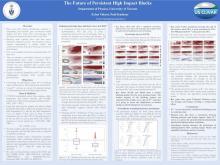Dynamical Insights on Hot and Humid Events Caused by Blocking Highs.
Eylon
Vakrat
University of Toronto Department of Physics
Poster
Heatwaves that involve simultaneous extremes in temperature and humidity pose well-known health dangers and have many other socio-economic and ecological consequences. Blocking highs that typically drive such heatwaves in European summer are characterized by slowly propagating quasi-stationary Rossby waves (QSWs) whose dynamics, surface impacts, representation in climate models, and sensitivity to climate forcing are of great interest. We investigate such events from synoptic and dynamical-systems perspectives in observations, reanalysis, and CMIP6 simulations. The events are defined in terms of extremes of the discomfort index (DI) that combines temperature and humidity. DI extremes at meteorological stations are well captured in reanalysis, and reanalysis further reveals that European DI extremes feature a strong blocking high in the lower troposphere and a ridge with relatively slow westerlies in the upper troposphere. In an independent analysis, dynamical-systems theoretic tools extract the most-persistent patterns of midtropospheric flow in European summer. This analysis reveals a strong spatial correspondence between the pattern of the most persistent circulation anomalies (high values of the persistence metric Θ-1) and the DI-extreme synoptic pattern. This connection also extends to historic CMIP6 simulations, at least for temperature anomalies, but the representation of high-humidity anomalies associated with the persistence patterns can be unrealistic in models. Interestingly, preliminary results show that the persistence of DI related events increases under projected greenhouse forcing, and we will report on the model dependence of these changes and initial thoughts on the dynamics of these changes. Thus, the dynamical systems viewpoint lets us cast a light on the future dynamics of the QSW and their important impacts related to damaging heat and humidity extremes.

Presentation file
Vakrat-Eylon-blocking-poster.pdf
(3.22 MB)
Meeting homepage
